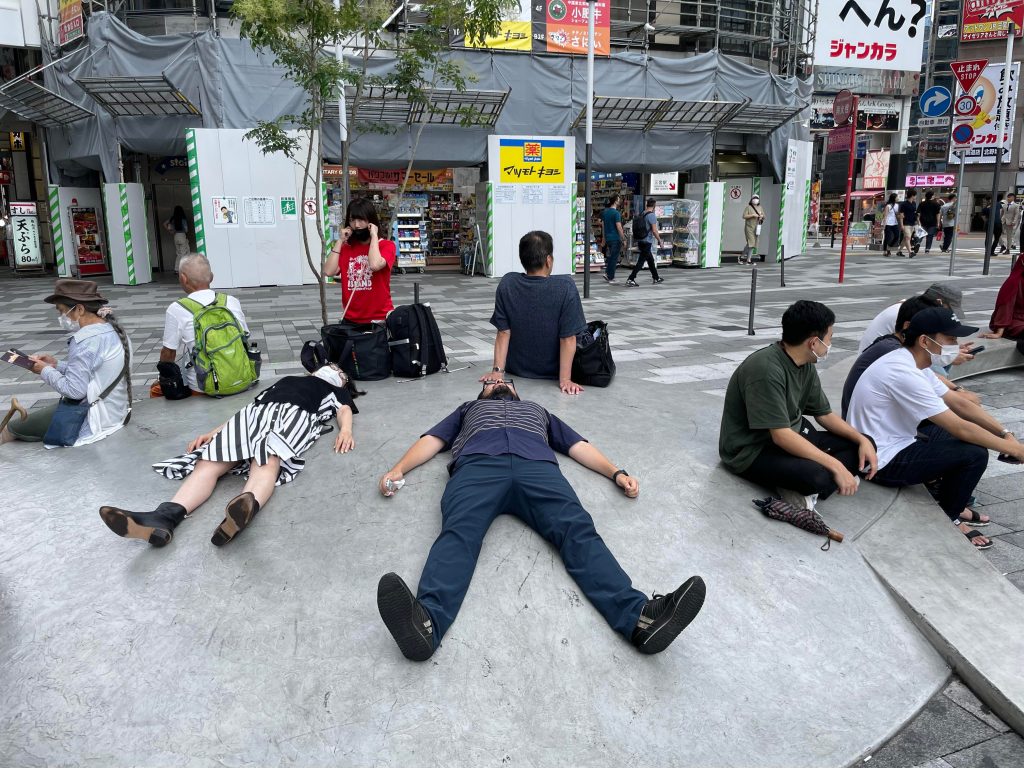I moved in the spring. I noticed something when I started living in this house beside a road: The area in front of our house is a space for people to hang out. The most frequent "visitors" are elementary school students on their way home from school. They drop their school satchels and write things on the roadway. Sometimes they even go up onto the front porch to play. When this happens, I have to enter the house making apologies for pushing past them, even though it is my own house.
Why in front of our house? Perhaps the reason is the particular location of the property. Our house is located at the entrance of a so-called "cul-de-sac". The front of our house faces a public street, but along the right side it is a private road that serves as a driveway that soon dead-ends, and there are seven nearly identical houses on both sides of it and across the end of it. From our point of view, it is more like a "courtyard" than a "driveway".
Since that road is just a dead end, it is where people hang out. It’s undoubtedly safe because no cars come in at breakneck speed, and playing there doesn’t disturb passersby. On the other hand, it doesn’t mean that cars and people don’t come in at all. A completely enclosed space can stir some unease, but in a cul-de-sac there is connection to the outside world. It’s a place where the flow of urban motion is guaranteed to slow down and stop, and then eventually regain speed and exit again. If I were to compare it to human internal organs, it would be like the alveoli that refresh components of the blood.
What is curious is that it’s always two or more who hang out in cul-de-sacs. Many people spend time alone in parks and squares, but that’s not so for cul-de-sacs. People stand around talking, playing catch, drawing on the ground.... There’s always some kind of exchange of information and things going on here. The cul-de-sac is not a place for rest, but for socializing.
But that’s the very reason cul-de-sacs have a bad reputation in the real estate world. Residents who don’t join in the socializing that goes on around them feel that the public space has been unfairly occupied. Moms stand around chatting too loudly, kids make so much noise that it’s sometimes hard to sleep... . When you look at the Internet, you will see quite a variety of such negative posts. To begin with, Japanese term for "cul-de-sac" is not used in any positive context. For example, when we say "The deliberations have entered a cul-de-sac," we are referring to the condition of being unable to find a solution.
Stopping somewhere gives rise to socializing, but it also sparks territorial disputes. How can we use such comfortable spaces together in our own ways without falling into the "tragedy of the commons"? It is in this space between "flowing" and "staying" that rita arises. It’s possible to solve this problem politically by establishing rules and regulations, but as a researcher of corporeality [the body and its uses], I would like to search for a different sort of solution.
At Sankita Amore Plaza in Sannomiya, for example, people are lying down and relaxing, despite the fact that it is right in front of the station. Sannomiya Station is Kobe's main terminal hub, but just a few steps after exiting the ticket gates the scene resembles nothing so much as a bathing beach!

Originally, this area was called "Pai-Yama," or "Pai Mountain," and was a favorite meeting place. It was renovated in 2021 in conjunction with redevelopment of the station area. The re-made plaza has a gently sloping hill that re-creates the original bowl-like structure. It’s on that slope that people lie down.
I had an opportunity to speak with architect Eri Tsugawa, who designed the plaza. In creating it, Tsugawa's goal was "to do the opposite of affordance". Instead of using so-called "exclusionary art," in which people's behavior is controlled by the environment, she wanted to liberate the potential of the body, as if everyone were a performer.
For example, in the plaza, there are long sloping benches in addition to small hills. The benches are of different heights, so sitting on them will naturally create variations in the postures of everyone present. People sitting on the higher part of benches have their legs dangling, while those sitting on the lower part are almost sqatting. Some people straddle their legs, as if they’re sitting on a seesaw, and others face in different directions. There is a truly surprising variety of "sitting."
The fact that each person’s posture was unlike anyone else’s seemed to give all the people in the space a place of their own. Among them was someone who appeared to be homeless. He was lying on the top of a small hill as if he were a specialist of "tamaru," but although such behavior in a public space would normally tend to make others exclude him, in fact it was creating followers here. A young man similarly was lying down for a nap right next to him. This space has an arrangement that makes it possible to be together by being scattered apart and different. The beach-like scene spread out in front of the station offers us clues for solving the cul-de-sac problem.

